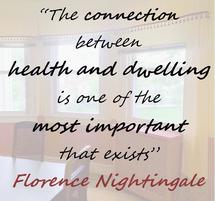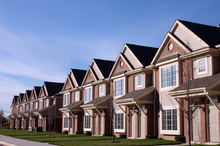 Imagine walking through your front door tonight. How do you feel? Relieved? Peaceful? Tense? Joyful? Supported? Overwhelmed? Are you looking forward to spending many more years watching the change of seasons outside your window and exchanging friendly waves with neighbors? Or are you counting down the days until you can leave and never look back? If reading those questions made you feel a little more relaxed or stressed you out, then you already know how much of a difference home can make in your overall health and well-being. The quality of your housing – from the condition of the building, to the layout of the rooms and windows, to the character of your block or neighborhood – has significant impact on the state of your mind, body and spirit. For people already living with behavioral health challenges, the constant stressors that come with poor quality housing can make it difficult to maintain wellness or even trigger crises. If your rooms are dark, damp or drafty, you might be at risk for health problems from mold or airborne illnesses. Pest problems like roaches and rodents certainly increase anxiety and can bring exposure to disease. Having to stay in a place that is falling down all around you because you can’t afford anywhere better can exacerbate depression and increase isolation. Even if the building where you live is in pretty good shape, feeling unsafe or unwelcome in your home or neighborhood makes it hard to form the habits and relationships that sustain a life in recovery. The good news is that living in quality, affordable housing in ‘neighborhoods of opportunity’ can promote better health outcomes, especially for people living with chronic illness. (1) Let’s look at some of the housing factors that can create positive benefits for health...  Affordable Rent = Time & Money for Self-Care What helps keeps you well? Eating a balance of nutritious foods, getting enough sleep and exercising regularly support mental health recovery and keep your body in good working order. Spending time with friends and doing favorite activities help you feel happy, hopeful and whole. Even for the thriftiest folks, self-care takes time and money. When rent and utility costs are overwhelming, too often people aren’t able to afford to take good care of their basic needs. Maybe you can’t afford fresh vegetables and proteins, so your diet becomes mostly processed meals-in-a-box or fast food take out. Maybe you have to pick up a second job to make ends meet, and no longer have time to be social or even to sleep. The stress and anxiety of constantly scrimping and saving to scrape together enough for the bills each month puts additional strain on your mental health. On the other hand, when your housing costs are stable and affordable, you can spend your time and money wisely on the things that keep you healthy. Quality Home = Healthy Environment Have you ever heard of “sick building syndrome (SBS)”? This term was coined to describe situations when people suffer health problems linked to spending time in a building, usually resulting from indoor air pollution or chemical contaminates. (2) Most people won’t ever experience a case of “SBS,” but thousands of people in poor quality housing do risk exposure to more common toxins like mold, lead paint or raw sewage. Other “severe housing problems” include overcrowding and lack of kitchen or plumbing facilities. (3) You can imagine how quickly germs and viruses spread when too many people live together in close quarters, or when households can’t practice good food safety and personal hygiene due to broken plumbing, a substandard kitchen or a pest infestation. Federal, state and local governments have created regulations and inspection practices to help homeowners and landlords reduce or eliminate toxic conditions like exposed lead paint, but there are still plenty of cases where individuals and families experience health problems due to lackluster maintenance in poor quality housing. Affordability plays a role here too; high mortgage and utility costs may exhaust funds, delaying important repairs. A quality, well-maintained home won’t just keep out the elements – it will be a comfortable sanctuary that supports healing, health and hope. Warm and inviting, home is where you can retreat at the end of a hard day and it forms a foundation for growing in new directions: starting a morning exercise routine, hosting friends for dinner, or exploring a passion or pastime.  Supportive Communities = Opportunities for Recovery What are the three most important words in real estate? Location, location, location! What’s good in your neighborhood? A robust community has the structure, services and amenities that people need to live full and productive lives: a mix of housing types; shopping centers with grocery markets, local and chain businesses; maintained sidewalks, bike paths and public transportation; health and social service providers; recreational areas, leisure activities and community events. Living in an environment where you feel welcome and have options about where to life, work, worship and play doesn’t just dictate how you spend your day-to-day; it has a significant impact on your health over the long term. The Deadly Costs of Poor Housing There’s a lot of research examining the complex connections between housing environment and health outcomes, especially regarding rates of chronic diseases like asthma, obesity and diabetes in low-income communities. (4) These health problems are also frequently experienced by people living with serious mental illness, and too often contribute to consumers’ premature deaths. (5) Simple strategies that help prevent many chronic health conditions – like taking a daily walk, eating a balanced diet and practicing self-care – aren’t so simple if your neighborhood isn’t safe, the grocery store is too far away, and your bank account has a negative balance. Speaking of safety, is there a connection between housing quality and exposure to trauma? We know that people living with a serious mental illness are over 10 times more likely to be the victims of violent crime than the general public. (6) Research by The Hamilton Project of The Brookings Institute also reports that low-income individuals living in disadvantaged areas are more likely to be a victim of personal crimes such as robbery, assault and violence. (7) It stands to reason, then, that consumers living in low-income neighborhoods face heart-wrenching odds of being a prime target for violence. What does recovery look like when paranoia and isolation are necessary survival strategies? Living in poor quality housing poses immediate and long-term risks to health and wellbeing. Does living in better quality, more affordable housing help maintain recovery? Can it prevent disease and disability? Every individual’s experience of how housing impacted their wellness will be unique, but common sense and scientific research both show that home really does make a difference when it comes to health. Originally published in the Spring 2016 Issue of Consumer Network News, the quarterly newsletter of On Our Own of Maryland, Inc. Footnotes 1. Rebecca Cohen. “The Impacts of Affordable Housing on Health: A Research Summary.” Center for Housing Policy: Insights from Housing Policy Research. May 2011. (http://www.nhc.org) 2. “Indoor Air Facts No. 4 (Revised): Sick Building Syndrome” United States Environmental Protection Agency (EPA), February 1991. (http://nepis.epa.gov/) 3. Maryland > Health Factors > Physical Environment > Severe Housing Problems (Data 2008-2012). County Health Rankings and Roadmaps. (http://www.countyhealthrankings.org) 4. Hood, Ernie. "Dwelling Disparities: How Poor Housing Leads to Poor Health." Environmental Health Perspectives 113.5 (2005): A310-317. (https://.ncbi.nlm.nih.gov) 5. MentalHealth.gov. “Mental Health Myths and Facts.” (http://www.mentalhealth.gov/basics/myths-facts/) 6. Mauer, Barbara, MSW, CMC. Morbidity and Mortality in People with Serious Mental Illness. Tech. no. 13. Ed. Joe Parks, Dale Svendsen, Patricia Singer, and Mary Ellen Foti. Alexandria: National Association of State Mental Health Program Directors, Medical Directors Council, 2006. (http://www.nasmhpd.org/) 7. Kearney, Melissa S., Benjamin H. Harris, Elisa Jacome, and Lucie Parker. Ten Economic Facts about Crime and Incarceration in the United States. Issue brief. Washington DC: Hamilton Project, 2014. (http://www.hamiltonproject.org/)
3 Comments
7/17/2018 09:28:05 am
Sports and activities are a vitally important thing for life and well being and for social interaction. More and more people are getting injured playing sports. They are lucky if they don't have to have surgery. Even with minor injuries such as low back pain, an ankle twist, or a wrist sprain, it is important to remember to take care of your bodies. It is vital to keep in mind that exercise does not necessarily build muscle, it actually breaks it down.
Reply
8/29/2018 04:16:44 am
Trenbolone Enanthate is one of the most powerful anabolic steroids of all time.
Reply
1/12/2022 09:53:11 pm
Thanks for pointing out that living in poor-quality housing poses immediate and long-term risks to health and wellbeing. This is helpful because my husband and I want to provide a safe and comfortable environment for our five kids. With this, we are hoping to talk with our community on Monday to have our neighborhood security patrol every night.
Reply
Leave a Reply. |
Archives
July 2018
Topics
All
Events Calendar |
Proudly powered by Weebly

 RSS Feed
RSS Feed